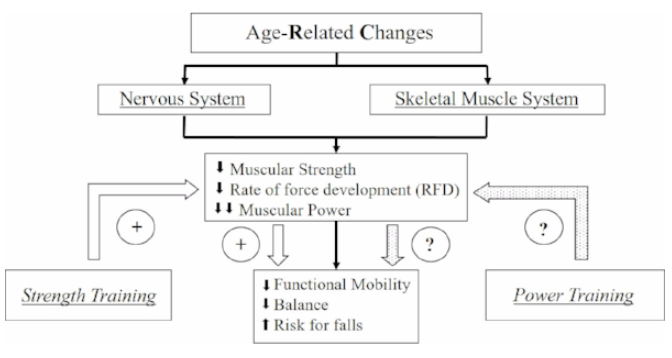As people get older, neuromuscular changes often result in an impaired ability to produce rapid force. Such a reduction in muscular power can then lead to functional mobility impairments, poor balance and an increased risk for falls. However, the mechanistic understanding of how reduced muscular power affects function and balance recovery, and how we can counteract it, is still lacking. This review selected studies that would provide further insight about the mechanisms that lead to the reported age-related loss of muscular power and functional impairments, as well as the benefits of power training compared to the traditional strength training approach for muscular performance, function and balance.
Our narrative review demonstrated that age-related reductions in nerve conduction velocity, discharge rate, number of functional motor units and available motorneurons are well-established. Furthermore, muscle architecture and composition, muscle contractility and selective denervation of type II skeletal muscle fibers (high force and fast contraction fibers) are also affected by old age. These age-related changes lead to reduced neural drive, rate of neuromuscular activation and reduced muscle mass, classically known as sarcopenia. Ultimately, these changes have an impact on muscular performance and the rate of force development, which are both a crucial for generating muscle power. This could explain why impaired muscle power is such a potent predictor of functional independence, functional impairments and falls.
It seems quite clear from the literature that these age-related changes in our muscles areinevitable. So should we just give up and accept our fate? Or can we actually defeat the laws of nature and reduce (or even reverse!) the rate of age-related decline through exercise training. There is evidence that strength resistance training can prevent neuronal denervation and increase neural drive resulting in a greater neuromuscular performance. However, this type of resistance training has limited effects on power production because it does not focus on velocity of execution. A potentially viable alternative is power training. This alternative focuses on fast, explosive movements to have a stronger effect on muscle power.
Our literature review revealed a large variability in the paradigms used for traditional strength and power training, which makes it difficult to draw firm conclusions. Nonetheless, there seems to be some evidence suggesting that muscle power training might be beneficial in older individuals for improving muscular performance and functional mobility. Future research could look at whether power training could also prevent falls and investigate the optimal dose to have a maximal effect on functional mobility.

Figure. Conceptual model for age-related changes that lead to functional impairments and how strength and power training can affect these changes.
Publication
Inacio, M. (2016). The Loss of Power and Need for Power Training in Older Adults. Current Geriatrics Reports, 5(3), 141-149. doi: 10.1007/s13670-016-0176-7.
About the Author

Mario Inacio, MS, PhD
Physical Therapy and Rehabilitation Science Department, University of Maryland
I am a postdoctoral fellow at the Physical Therapy and Rehabilitation Science Department in the University of Maryland, Baltimore. My research interests are in understanding the neuromuscular mechanisms of balance control and fall prevention, with emphasis in muscular performance and power production.
Copyright
© 2018 by the author. Except as otherwise noted, the ISPGR blog, including its text and figures, is licensed under a Creative Commons Attribution-ShareAlike 4.0 International License. To view a copy of this license, visit https://creativecommons.org/licenses/by-sa/4.0/legalcode.
ISPGR blog (ISSN 2561-4703)
Are you interested in writing a blog post for the ISPGR website? If so, please email the ISGPR Secretariat with the following information:
- First and Last Name
- Institution/Affiliation
- Paper you will be referencing
